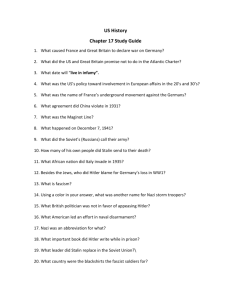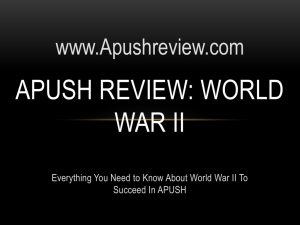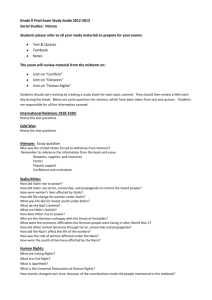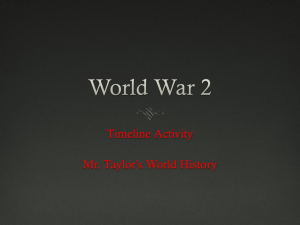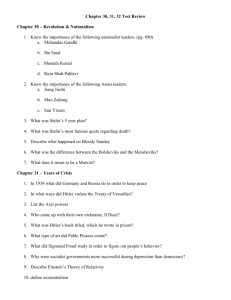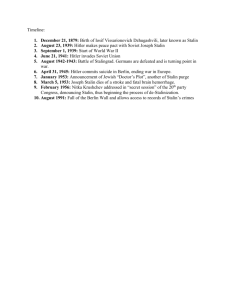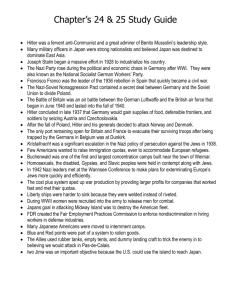wwii test-key
advertisement
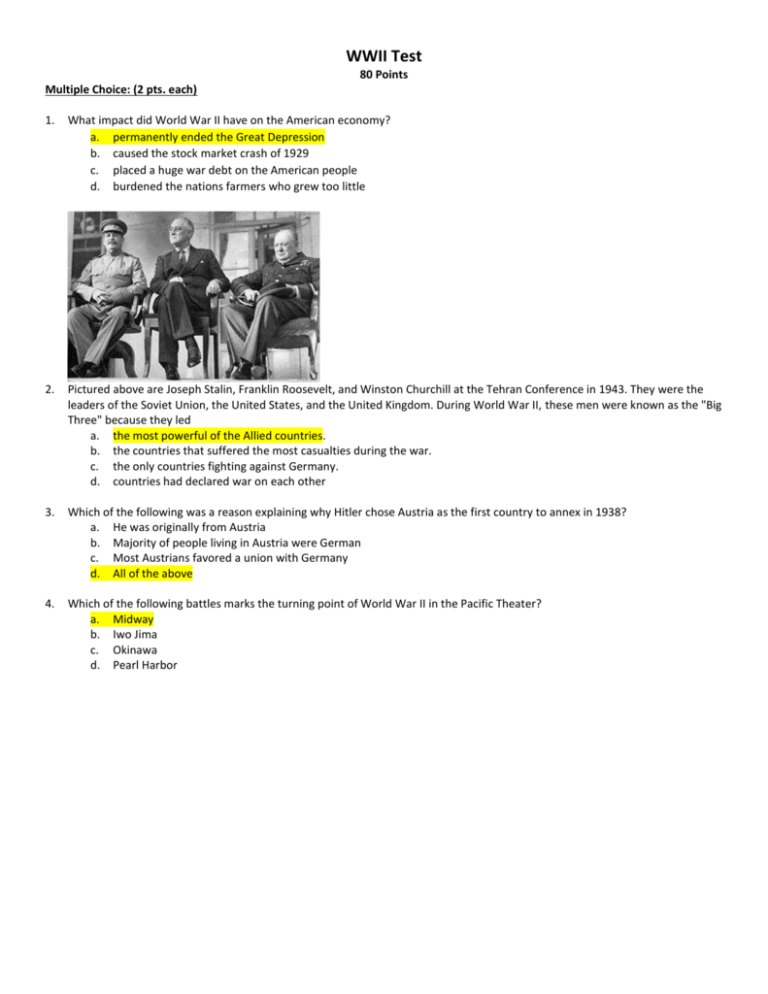
WWII Test 80 Points Multiple Choice: (2 pts. each) 1. What impact did World War II have on the American economy? a. permanently ended the Great Depression b. caused the stock market crash of 1929 c. placed a huge war debt on the American people d. burdened the nations farmers who grew too little 2. Pictured above are Joseph Stalin, Franklin Roosevelt, and Winston Churchill at the Tehran Conference in 1943. They were the leaders of the Soviet Union, the United States, and the United Kingdom. During World War II, these men were known as the "Big Three" because they led a. the most powerful of the Allied countries. b. the countries that suffered the most casualties during the war. c. the only countries fighting against Germany. d. countries had declared war on each other 3. Which of the following was a reason explaining why Hitler chose Austria as the first country to annex in 1938? a. He was originally from Austria b. Majority of people living in Austria were German c. Most Austrians favored a union with Germany d. All of the above 4. Which of the following battles marks the turning point of World War II in the Pacific Theater? a. Midway b. Iwo Jima c. Okinawa d. Pearl Harbor 5. The picture above is from the Munich Conference where Hitler, Mussolini, Edouard Daladier, and Neville Chamberlain met to discuss Hitler’s annexation of the Sudetenland. During the conference the leaders agreed on the strategy of giving into Hitler’s demands in order to prevent war. What is this strategy called? a. Isolationism b. Appeasement c. Militarism d. None of the above 6. _________________ refers to the mass execution or elimination of people (8-13 million) that threatened Joseph Stalin’s totalitarian government in the Soviet Union. a. Great Death b. Holocaust c. Russian Elimination d. Great Purge 7. The Neutrality Acts passed by the United States as part of a policy of isolationism during the 1930s were, in part, a response to a. imperial conquests by the USSR in South Africa. b. spreading anxieties regarding nuclear warfare. c. aggression of China against the Japanese. d. growing conflicts in European and Asian countries 8. What was the significance of World War II's Normandy Invasion, commonly referred to as D-Day? a. It marked the beginning of the end for Nazi Germany. b. It promptly pulled the United States out of World War II. c. It marked the first use of the atomic bomb in a war. d. It prompted a peace summit that ended World War II 9. The image used above is a propaganda poster from World War II. The man in the poster represents a famous group of African Americans who fought in the war. They were known as the a. American Expeditionary Forces. b. 442nd Regimental Combat Team. c. 82nd Airborne. d. Tuskegee Airmen. 10. The man pictured above served as the Japanese Prime Minster during much of WWII. Who is he? a. Chiang Kai Shek b. Mao Zedong c. Hideki Tojo d. Zeng He 11. Which of the following was an agreement reached by Hitler and Stalin in which their countries committed to never attack each other? a. Nazi-Soviet Pact b. Nonviolent Union c. Nonaggression Pact d. Poland Pact 12. Which of the following refers to the research and development of the atomic bomb by American scientist during WWII? a. Manhattan Project b. Truman Project c. Oppenheimer Project d. Nuclear Development Project 13. _________________ was a book written by Adolf Hitler while serving a prison sentence where he outlined his plans for Germany. a. Lebensraum b. Third Reich Objectives c. Mein Kampf d. The German Problem 14. The picture above is an iconic image from World War II and symbolizes which of the following? a. the millions of women who joined the workforce in heavy industry b. the women who joined the armed forces in combat roles c. the women who ferried supplies into combat areas during the war d. the important work done by Red Cross nurses during World War II 15. During World War II, General Douglas MacArthur led the U.S. forces in the Philippines and surrounding areas. MacArthur was also the military general who a. required the immediate evacuation of London. b. traded U.S. military secrets with the Chinese. c. started a nuclear war with Cuba and the U.S.S.R. d. accepted Japan's surrender in September 1945 16. From November 28-December 1, 1943, Joseph Stalin of the Soviet Union, Winston Churchill of Britain, and Franklin D. Roosevelt of the United States met together in what was known as the Tehran Conference. It was the first World War II conference among the Big Three (the Soviet Union, the United States, and the Britain) in which Stalin was present. What was one major negotiation reached at the Tehran Conference? a. The Potsdam Declaration was issued asking for Japan's surrender. b. Operation Overlord, also known as D-Day, was scheduled for France. c. The Pacific Charter was outlined for the Allies' action plan for Asia. d. The division of Germany would be split into four occupation zones. 17. The man pictured above was the Fascist leader Italy starting in 1921 and would later form an alliance with Adolf Hitler to form the Axis Powers. Who is he? a. King Victor Emmanuel b. Benito Mussolini c. Joseph Stalin d. Klaus Von Staffenburg 18. Which of the following me seceded FDR as President of the United States and is most notably remembered for his decision to end the war with the Japanese by using the A-bomb? a. Dwight D. Eisenhower b. Harry Truman c. John F. Kennedy d. Ronald Reagan 19. What impact did the Japanese attack on Pearl Harbor have on World War II? a. Japan surrendered to the Allies the following day. b. Italy surrendered and united with the Allies. c. It pulled the United States into World War II. d. The Pacific Charter was organized against Japan. 20. Why was World War II's Battle of the Bulge important? a. It prompted Italy to surrender, leaving Germany and Japan to fight the Allies. b. It was the final major Nazi offensive against the Allied forces in the war. c. It distracted the U.S. so Japan could launch a surprise attack on Pearl Harbor. d. It opened a path for German forces to attack the Soviet Union in Stalingrad. 21. The man pictured above was one of the greatest generals in U.S. military history and was specifically tasked with U.S. military operations in the Pacific. Who is he? a. Dwight D. Eisenhower b. Douglas MacArthur c. George Patton d. Andrew Jackson 22. What was the reasoning of the United States government for placing thousands of Japanese Americans into internment camps? a. Japanese Americans were quarantined to prevent a small pox outbreak. b. The U.S. government wanted to offer protection to Japanese Americans. c. The U.S government wanted to train Japanese Americans to fight in the war. d. Many Americans were concerned about the loyalty of Japanese Americans 23. The image above immortalizes which important World War II battle? a. Iwo Jima b. Okinawa c. Pearl Harbor d. Midway 24. Why did Congress pass the Lend-Lease Act and amend the Neutrality Acts in 1941? a. to allow the U.S. to lend military equipment and supplies to any nation the president said was vital to the defense of the U.S. b. to limit the amount of military equipment and supplies sent overseas c. to permit landlords to lend or lease housing for American troops overseas d. to allow a means for the U.S. military to build military bases on foreign soil 25. Shortly after the United States entered World War II in 1941, Franklin Roosevelt and British Prime Minister Winston Churchill met at the Arcadia Conference in Washington, D.C. At this conference, the two leaders agreed on a strategy known as "Germany First" in which they agreed to concentrate their war efforts on defeating Germany. Why did the United States and the United Kingdom think this would be an effective strategy? a. They viewed Germany as the greatest threat in the war. b. They thought Germany would be the easiest country to defeat. c. They wanted to take control of all German territory. d. They wanted to prevent Germany from invading France. 26. The man pictured above was the British Prime Minster following Neville Chamberlain that opposed Hitler’s aggression and would lead Great Britain through WWII. Who is he? a. Douglas MacArthur b. Winston Churchill c. James Doolittle d. Dave Ramsey 27. The Potsdam Declaration called for the immediate surrender of Japan or else they would face "prompt and utter destruction." Japan's refusal to surrender led directly to which of the following? a. the dropping of the atomic bombs b. the Japanese attack on Pearl Harbor c. the invasion of France at Normandy d. the creation of the United Nations 28. From July 17 to August 2, 1945, leaders from the Allied nations met at the Potsdam Conference to decide what sanctions to put in place against the recently defeated Nazi Germany. During the conference, the decision was made that certain industries in Germany would be a. brought back to their pre-World War I levels. b. disabled in order to destroy potential for war. c. governed by the forces occupying the country. d. revitalized because the war had damaged them. 29. The USSR pledged which of the following at the Yalta Conference in February of 1945? a. to foster communism in nations taken from Germany b. to disarm as quickly as possible once the war ended c. to attack Japan within three months of German surrender d. to open a second front in the war by invading France 30. Which of the following best explains why President Harry S. Truman decided to drop the atomic bombs on Hiroshima and Nagasaki at the end of World War II? a. He wanted to avoid an American invasion of Japan. b. He wanted Germany to surrender unconditionally. c. He wanted to wait for the USSR to join the war. d. He wanted the war to last as long as possible 31. Which World War II military general, who was also the Military Governor of the American Occupation Zone in Germany, was elected president of the United States? a. Lyndon B. Johnson b. Dwight D. Eisenhower c. John F. Kennedy d. Richard Nixon Letter from Einstein to Franklin D. Roosevelt on August 2, 1939 "Some recent work... leads me to expect that the element of uranium may be turned into a new and important source of energy in the immediate future... This new phenomenon would... lead to the construction of bombs, and it is conceivable... that extremely powerful bombs of a new type could thus be constructed. A single bomb of this type, carried by a boat and exploded in a port, might very well destroy the whole port as well as some of the surrounding territory. However, such bombs might prove to be too heavy for transportation by air. In view of this situation, you may think it desirable to have some permanent contact between the Administration and the group of physicists working on chain reactions in America." —Albert Einstein 32. Which of the following best describes the result of the letter above from Albert Einstein to Franklin D. Roosevelt as it relates to World War II? a. the discovery that nuclear reactions could be used to create energy b. the establishment of a project in Los Alamos to develop the first atomic bomb c. the use of nuclear power as an alternative energy source to fossil fuels d. the arms race to produce nuclear weapons between two world superpowers 33. A controversy regarding the use of the atomic bombs at the end of World War II began almost immediately after the war. Those who argue against the use of the atomic bombs state that a. they led to the surrender of Japan. b. they were needed to end the war. c. they made an invasion unnecessary. d. they were not required militarily. 34. Which of the following were a series of trials held to punish the surviving Nazi leaders for the injustices they had committed before and during WWII? a. Paris Peace Trials b. Berlin Court Series c. Nuremberg Trials d. Axis Party Trials 35. The man pictured above was the communist leader of the Soviet Union during WWII. Who is he? a. Vladimir Lenin b. Leon Trotsky c. Joseph Stalin d. Nikita Khrushchev 36. Which of the following refers to the German military strategy where modern technology combined with speed and force to surprise and overwhelm their targets? a. Luftwaffe b. Blitzkrieg c. Aggressive Advancement d. Both A & C 37. Which of the following terms refers to the mass execution and deportation of Jews and other groups deemed undesirable by Hitler and the Nazis? a. Nazi Project b. Jewish Purge c. Holocaust d. Hitler’s Mandate 38. On May 8, 1945 the Allied forces accepted an official surrender of the German Third Reich. Which of the following refers to the name of this day that was celebrated worldwide? a. VE Day b. D-Day c. World War Ending Day d. World Peace Day 39. Which of the following battles was a major turning point for the Allies in the Eastern theatre of the war in which Hitler suffered a devastating loss at the hands of Stalin’s Red Army? a. Berlin b. Britain c. Midway d. Stalingrad 40. The main objective of Operation Overlord (D-Day) was to liberate which of the following countries? a. England b. Germany c. France d. Japan

